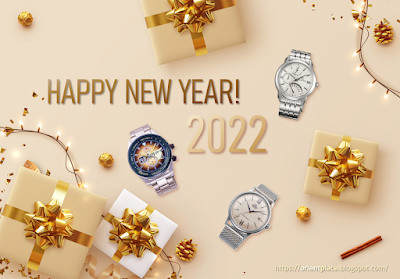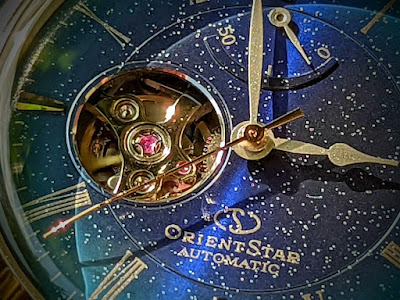The latest generation of Orient Star Classic Semi-Skeleton watches was introduced
about three months ago. Shortly afterward, Orient presented a limited-edition
version of that model, featuring a deep blue dial adorned with little sparkles.
This model, reference RE-AT0205L (or RK-AT0205L in Japan) is the subject of
today's review.
How It Looks
The new semi-skeleton immediately stands out among other members of the
Orient Star Classic line-up. Whereas the rest of the crop feature lugs that
project very markedly from a round case, here the case and lugs flow together
seamlessly.
Somehow, this flowing shape makes the watch look radically different
from its predecessor. Despite the familiar Orient elements, like the
power-reserve indicator and (obviously) the open-heart aperture, the overall
feel of this timepiece is very un-orient-like.
More precisely, it is unlike most men's Orients. Its design makes more
sense when viewed next to some of Orient Star's recent ladies models: that's
where you will find more of these smoothly flowing cases. Now add the cabochon,
set into the crown of the new Semi-Skeleton, and it becomes clear this isn't
less Orient-ish than past models, it is just a little less masculine.
There's nothing wrong with having a watch that is more subtle in its
gender specificity. Looking at many classic Swiss dress watches, you can
appreciate that their styling is actually more unisex than either male or
female. Quite possibly, it was this timeless European elegance that Orient's
designers were aiming for.
And elegant it is. Polished all over, with that domed crystal covering
the blue dial with its elongated markers and hands. The power reserve indicator
is less pronounced than in most other Orient Star semi-skeletons, so there is
no apparent need to counter-balance it with a small-seconds sub-dial at 6. The
centrally mounted second hand is therefore well fitted here.
Now, many readers would, at this point, likely complain about the
open-heart. A common claim is that many Orient watches would look better with a
full dial. Well, I tried to simulate what this model would look like if it was
not a semi-skeleton; well – I don't know, it just seems less interesting to me.
More classic dress watch perhaps, but we've got plenty of those, right? And
then it wouldn't be an Orient.
The dial looks particularly fine when some stronger light shines on it.
Then, the navy blue dial becomes more vibrant, revealing lighter shades and
even some greenish hues around the edges. The flat hour markers wear warmer
tones, and those tiny dots begin to glitter.
The hands and applied markers aren't the sharpest I've seen on an Orient
Star, but they are still nice enough. Overall, the dial just works – it is well
balanced, and is as elegant as the case.
How It Wears
This Orient Star makes for very comfortable wear, thanks to its moderate
dimensions, smooth case, and well-made strap and buckle.
It is a tad larger than the previous model: case width is 40.4mm without
the crown, length is 46.6mm, and thickness is 12.8mm. The watch weighs 74g on
the strap – considerably less than, say, the 90g of the layered
skeleton on leather.
These dimensions make it a fairly versatile watch – it would wear
perfectly on wrists 6.5"-7.5". I reckon it should still be
comfortable on 6" wrists as well, though it would look a bit on the larger
side, and therefore perhaps more sporty and less dressy.
The 20mm strap supplied with this watch is of good quality (and has a
very strong leather odor when unboxed, which I like). It was initially a little
stiff, but did not take more than an hour or two on the wrist to break down and
become flexible enough – while being nicely padded and not overly soft.
The folding buckle attached is also well made. I've seen it before on
Orient watches, and it really is good – it feels secure, easy to use, and very
smooth and unobtrusive on the skin.
How It Functions
The Classic Semi-Skeleton is equipped with Orient's caliber F6R42. This
movement offers a 50 hour power reserve, and declares an accuracy of +25/-15
seconds per day. On my review sample, the watch actually did a mere +5 seconds
per day; and when being put to rest a couple of days, while its power lasted,
only lost a couple of seconds per day.
Checking the time on this watch is a simple affair. The hour and minute
hand contrast clearly against the dark dial. Thanks to this, low light
legibility is more than acceptable for a dress watch, despite having no lume on
the hands or markers.
Crown operation is decent, though a slightly larger crown would have
been more convenient. Winding feels a little rough, as in some Orient watches,
but setting the time is a breeze (as would be expected).
As far as everyday usability, this is a dress watch and should be
treated as such. The highly polished case and non-sapphire crystal are not
intended to be worn working in the silver mines, and the 5 bar water resistance
means you are not going to go shark hunting with this watch, either (by the
way, I strongly recommend against hunting sharks anyway).
The Bottom Line
The new Orient Star Classic Semi-Skeleton is a handsome watch that takes
a slight diversion from the familiar design lines of the brand. It's not just
the case that is more polished, it is the whole concept. In this respect it is
somewhat reminiscent of the Orient
Star Diver, as both watches do not ignore the traditional aspects
and DNA of the brand, but instead deliver them in a more rounded package,
possibly aiming to attract buyers outside the existing circle of fans.
Whether one likes the new design or not, and whether one prefers it over
the old styling or not, is totally subjective. What is objective, is that the
quality is definitely there – the mechanics are sound, the finishing is fine,
and attention has certainly been given to little details such as can be found
on the dial and crown.
The new model can be found online nowadays at around $500 USD, slightly
below the official price. This is about 100 dollars lower than current asking
prices for the previous model (ref. RK-AV0011L would be the closest in terms of
dial color).
This represents good value, whichever way you look at it. Indeed the
lack of sapphire may be offputting to some, but I understand that Orient were
looking for a warmer, old-school vibe here with that purposefully domed mineral
glass. Clearly, when Orient wants to put sapphire in their watches they do it,
at almost any price point.
Bottom line is, if you find the new design attractive, you are likely to
enjoy this watch. There is nothing wrong with it – it is comfortable, legible,
and well-made. And if you find this limited edition's dial too glitzy for your
liking, there are three other versions to choose from.
The blog would like to thank Orient – Epson Europe for providing us
this limited edition Orient Star Classic Semi-Skeleton watch for review.

























































